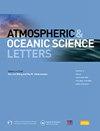北巴西大陆架的最大海面盐度舌
IF 3.2
4区 地球科学
Q3 METEOROLOGY & ATMOSPHERIC SCIENCES
引用次数: 0
摘要
土壤湿度和海洋盐度任务提供的海洋表面盐度测量的变异性揭示了热带大西洋西北部存在局部盐度最大值(咸舌)。海面盐度正异常从7月开始增加,1月达到最大值,然后消失。局部盐度最大值出现在北方寒带秋冬后期,此时亚马孙流量最小,南大西洋的咸水被北巴西洋流沿大陆架断裂输送到赤道。作者对该地区的卫星观测结果进行了验证,并利用现场测量和现场插值结果对盐度最大值的垂直结构进行了评价。本文章由计算机程序翻译,如有差异,请以英文原文为准。

A maximum sea surface salinity tongue in the North Brazil continental shelf
The variability of the sea surface salinity measurements provided by the Soil Moisture and Ocean Salinity mission reveals the presence of a local salinity maximum (a salty tongue) in the northwestern tropical Atlantic. The sea surface salinity positive anomaly starts increasing in July, reaches its maximum in January, and then disappears. The local maximum of salinity appears in the late boreal autumn/winter, when the Amazon discharge is minimal and the salty water from the South Atlantic is transported by the North Brazil Current along the shelf break across the equator. The authors validate the satellite observations in this area and assess the vertical structure of the salinity maximum by using in situ measurements and an in situ-interpolated product.
求助全文
通过发布文献求助,成功后即可免费获取论文全文。
去求助
来源期刊

Atmospheric and Oceanic Science Letters
METEOROLOGY & ATMOSPHERIC SCIENCES-
CiteScore
4.20
自引率
8.70%
发文量
925
审稿时长
12 weeks
 求助内容:
求助内容: 应助结果提醒方式:
应助结果提醒方式:


